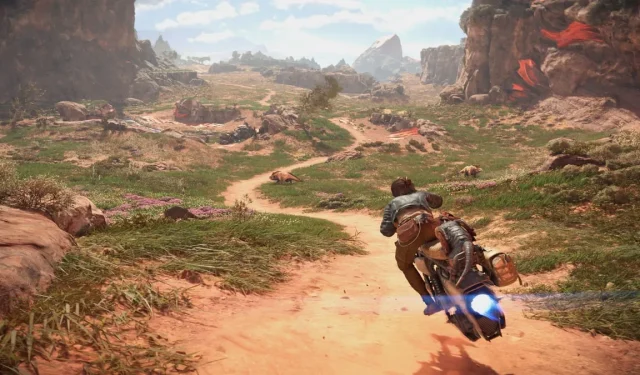
While the planets in Star Wars Outlaws may not evoke the “I could settle here” charm akin to that found in Bethesda’s titles, they do evoke a sense of “Skyrim in space” that feels closer than the myriad worlds presented in Starfield—a feeling the latter game promised us outright.
Both Outlaws and Starfield offer similar concepts of open-world exploration in space. However, Outlaws generally surpasses its counterpart in many aspects, albeit it still has room for improvement. We can think of it as a refined step forward—a sleek, more polished, and concise interpretation of what Starfield aimed to achieve. While Starfield emphasizes its expansive reach, Outlaws cleverly creates an illusion of vastness. Instead of providing countless planets to explore, Outlaws focuses on delivering a select few carefully crafted environments.
In both titles, the open terrains on planetary surfaces are confined to small segments of much larger celestial bodies. In Outlaws, every accessible area feels attainable, and reaching them doesn’t evoke feelings of disappointment. Along my journey, I always find intriguing rewards—whether it’s a hidden treasure, an unexpected meeting with an NPC offering a side quest, or an engaging skirmish with an aggrieved crime faction. In contrast, even the most densely populated areas in Starfield appear as expansive, desolate landscapes dotted with abandoned outposts, stretching endlessly.
The major urban centers in Starfield resemble glorified playgrounds. They often lack the captivating familiarity I experienced when entering locations like Riften in Skyrim or Diamond City in Fallout 4. I felt guided by waypoint markers rather than a compelling architectural landmark drawing me in to explore up close.
Navigating to certain zones can be tricky, as Outlaws tends to obscure its ideal paths leading up mountains and into faction bases a bit too effectively. That said, cities and points of interest are interconnected by pathways and hidden routes that invite exploration, while still steering players towards significant locations that hint at captivating secrets along the way.
Similar to Starfield, Outlaws is divided into sections that necessitate loading screens. To take off, you initiate an animation, after which the gameplay resumes once you’ve reached space. Just outside any planet lies a thriving open-world space area, abundant with activities, views to absorb, missions to undertake, and a plethora of space combat experiences.
The space-related elements in Outlaws feel less like essential gameplay components. This sentiment holds true for Starfield as well; both titles suffer from an overambitious design that hampers their execution. Fortunately, the celestial worlds in Outlaws align with its terrestrial environments in design philosophy. Space is inherently three-dimensional, and while anything can be placed anywhere, Massive Entertainment primarily populates locations along a singular plane.
If you’re looking to embark on a perilous mission at the imperial space station, it’s conveniently located just beside the spaceship graveyard, which is next to a fueling station. Every engaging activity in the void of space is within 20 seconds of each other, fostering that gratifying, Skyrim-like sensation of serendipitous discovery that can lead you astray on your original quest. Outlaws harnesses a sense of seamless exploration—a staple of earlier Bethesda games—that felt notably absent in Starfield.
The philosophies of each game’s open world extend into their character advancement systems. Starfield’s progression relies on XP accumulation to enhance your skills within the menus. Conversely, Outlaws integrates the skill development directly into the gameplay. To improve your hacking skills, for instance, you seek a hacking instructor, who assigns missions and challenges that span the entire map. Exploration directly correlates to skill improvement. Unfortunately, this also means you must confront the game’s more significant flaws regarding stealth and combat, but it represents a solid concept at its foundation.
Outlaws aims to incorporate elements reminiscent of Assassin’s Creed but lacks the refined tools and mechanics to allow players to effectively manipulate NPC interactions. The game features tall, swaying grass akin to the Horizon series, but when a rare enemy strolls by directly within sight of another foe, initiating a stealth attack feels risky at best. It borrows concepts from various open-world stealth games but misses the essence of why or how those mechanics function. As for combat mechanics, even if Bethesda has not perfected its approach, they know how to apply them effectively within the environments they create. It is evident Massive Entertainment has room for growth.
I sincerely hope that they learn and implement these lessons in a future sequel, regardless of the current underperformance of Outlaws. The game has its rough patches, yet the groundwork for an engaging open world exists, waiting for refinement. Outlaws clearly articulates the aspirations laid out by Starfield more effectively than its competitor.
Ultimately, it partially fulfills the vision of a distinctly different title that itself claimed to deliver a familiar experience in an alternate universe. While Starfield may never embody “Skyrim in space” —a concept I yearned for since its announcement—I’m pleased that Star Wars Outlaws has brought us a step closer, though much progress still lies ahead.
![Evil Dead 2 RPG Supplement: Introducing Blood, Sweat, and Fears to Enhance Your D&D Gameplay [EXCLUSIVE]](https://cdn.peacedoorball.blog/wp-content/uploads/2024/12/art-of-ash-williams-with-blood-dripping-down-his-face-flanked-by-two-characters-from-the-evil-dead-rpg-supplement_-a-bearded-man-holding-a-torch-and-a-robed-man-wielding-a-cross-and-a-book-64x64.webp)



Leave a Reply